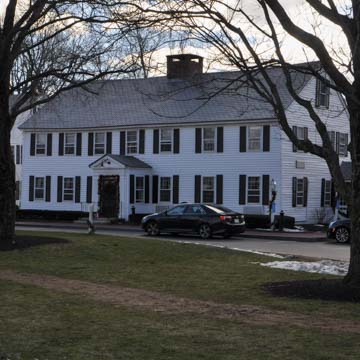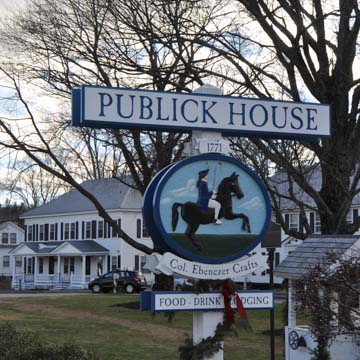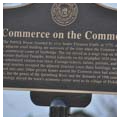You are here
Publick House
The Town of Sturbridge, sixty-seven miles west of Boston, once occupied an exceedingly important crossroads of the Boston Post Road (to New York) and a major north-south roadway connecting Springfield and Providence, Rhode Island, though a modern highway interchange has greatly diminished the town’s geographic significance. Sturbridge’s location during the colonial period at this intersection made it the ideal spot for a building type strongly associated with New England: the tavern, where travelers could stay the night and eat a prepared meal and where residents could learn the latest news and conduct trade.
For this reason, in 1771–1772, Connecticut-born entrepreneur Ebenezer Crafts tore down an existing single-room structure on the town green, near the roadway intersection, and erected the two-story, double-pile, clapboarded, Georgian-style building on a fieldstone foundation with the help of local builder Joshua Payne. Crafts reportedly gave it the name Publick House in reference to a statement by one of Sturbridge’s prominent families, the Saltonstalls, who donated the land of the town green “For Publick Use Forever.”
The original structure featured a center-hall plan that terminated at a single center chimney, which heated the large rear kitchen and several ground-floor public rooms. The kitchen, mainly staffed by women in the colonial and early national periods, serviced the tavern’s eating space, colloquially called the “tap room,” which also served rum, cider, and brandy, among other beverages. Overnight guests often received a light meal in this room as part of the cost of their stay, though travelers passing through could also stop and purchase meals here. In an adjacent room, Crafts himself sold dry goods, including sugar, thread, tea, eye glasses, and nails. An unheated, adjoining space served as a smoking room and functioned as a gendered space accessible to men only. This latter space served an important civic function in colonial and early republican Massachusetts generally as a gathering place for business transactions and spreading news. Behind this male-only space is the “Ladies Parlor,” a similarly gendered space where women were allowed to gather and where reportedly one could hear the conversations in the adjacent (men’s) room. A final ground-floor space operated as a mailroom for townspeople. Crafts reportedly made weekly trips to Boston for this service to help attract business to his establishment. The second story and garret contained thirteen overnight guest rooms, accommodating four people to each bed, allowing the Publick House to shelter up to 52 guests.
During the Revolutionary War, Sturbridge Common saw some military activity, including militia drilling and supplies collection. Crafts himself (now a colonel) personally equipped a company of cavalry for George Washington’s Army, using the Publick House as base. A nationwide, post–Revolutionary War depression brought economic hardship to Crafts and the tavern, and so he sold it in 1784 and moved to Vermont to try his fortunes there.
Taverns typically served more than their immediate patrons; they also helped facilitate town development in the early nineteenth century, which fed into the later nineteenth-century romantic creation of the iconic New England Village. While New England colonial villages did have town greens, these were not often commercial landscapes. For example, by the time of the Revolution only the meetinghouse and perhaps a tavern, like the Publick House, would have existed in proximity to the town common. This was the case in Sturbridge, and the erection of the tavern in the final years of the colonial period showcases not the colonial heritage of Sturbridge, but the changes taking place in the late eighteenth and early nineteenth centuries. In just the twenty years after Crafts built the Publick House, the Common became encircled by two blacksmiths, a hatter, and a physician’s office. By 1805, it boasted another blacksmith (reflecting the growing amount of horse traffic, since blacksmiths often reshod horses), a trader, and two stores. A decade later, it included a lawyer’s office, and by 1825 a mechanic’s shop, wagon maker, and multiple private houses. By 1835, just before the coming of the railroad, Sturbridge had fully adopted the early-nineteenth-century New England Village form, a development that the Publick House initially spurred. Thus, the Publick House belongs to the initial core of the town and was not a later addition to a thriving commercial strip.
The Publick House remained in operation at its prominent location, serving as an important waypoint for the transport of material and men during the War of 1812. Outside military activities, its location and size made it a favorite stopping place for the teamsters. It even briefly hosted General Lafayette and his son, George Washington Lafayette, in 1824. By the 1850s the railroads had bypassed Sturbridge, which reduced the town’s geographic advantage. Business at the Publick House languished as fewer and fewer travelers passed by. The tavern changed hands several times in the latter half of the nineteenth and early twentieth centuries, though it was always continuously operated in its original capacity during this time of decline.
In 1923 the property was purchased and converted into a boarding house for women and renamed The Elms, but it only served this function for a short time. In the 1930s, the Publick House faced harsh economic realities but found a new owner in Richard Paige, who made major interventions into the now-neglected structure. Influenced by Colonial Revival fervor, Paige hoped to restore the building and grounds to its days as a tavern and inn and hired architect James A. Britten and landscape architect Rod Colton to assist with his vision. Colton replaced dying elms along the adjacent common with large-size transplants. In the building, Paige and Britten removed later partition walls and ceilings to expose framing members in the building proper. They restored the Publick House name and added a rear ell, dubbing it “Crafts Hall” for the colonial proprietor. During World War II, Paige allowed the U.S. Army to occupy the expanded building as a post for soldiers en route to training in other areas. In the 1960s, he moved a colonial residence from elsewhere in Sturbridge, in the vein of Old Sturbridge Village (founded 1946) across town, to create another addition to the Publick House. The Publick House saw its fourth (and final) addition in the 1980s when Paige’s successor, Buddy Adler, hired Powers, Ltd., to erect “Paige Hall” in his honor.
Thus, today the overall structure does not entirely resemble the colonial tavern bearing its name, but appears more as a colonial-era facade in front of a series of incongruous ells and other architectural accretions. This appearance provides material evidence of the changes over time that Sturbridge saw as it transitioned from a colonial crossroads through a period of economic decline to the postwar commercial restoration. It demonstrates the aspirations of New England as well as its cultural survival. The Publick House still operates as a lodging and dining place as well as a site for weddings. It is not in close proximity to Old Sturbridge Village, a collection of relocated colonial and early national structures arranged to recreate a New England village and agricultural aesthetic, nor does it share any affiliation with that entity. However, its twenty-first-century operation approaches cultural heritage tourism in a similar manner to that of Old Sturbridge Village in its attempt to recapture the charm of a previous era to boost a small-town economy.
References
Burns, Brian, ed. Footsteps through History: A Walking Tour of Sturbridge Common and Southbridge. Worcester, MA: Worcester Country, 1984.
Burns, Brian. Sturbridge: A Pictorial History. Norfolk, VA: Donning Company Publishers, 1988.
Publick House Historic Inn and Country Lodge. Sturbridge and Its History. Pamphlet. Sturbridge, MA: Publick House, n.d.
Publick House Historic Inn and Country Lodge. Publick House History Long Version. Pamphlet. Sturbridge, MA: Publick House, n.d.
Publick House Historic Inn and Country Lodge. Publick House History Short Facts. Pamphlet. Sturbridge, MA: Publick House, n.d.
Wilken, Agnes S. “Form B – Building: “Publick House,” Sturbridge, MA (STU.36).” Boston: Massachusetts Historical Commission, February 1971.
Wood, Joseph. The New England Village. Baltimore: Johns Hopkins University Press, 1997.
Writing Credits
If SAH Archipedia has been useful to you, please consider supporting it.
SAH Archipedia tells the story of the United States through its buildings, landscapes, and cities. This freely available resource empowers the public with authoritative knowledge that deepens their understanding and appreciation of the built environment. But the Society of Architectural Historians, which created SAH Archipedia with University of Virginia Press, needs your support to maintain the high-caliber research, writing, photography, cartography, editing, design, and programming that make SAH Archipedia a trusted online resource available to all who value the history of place, heritage tourism, and learning.





















